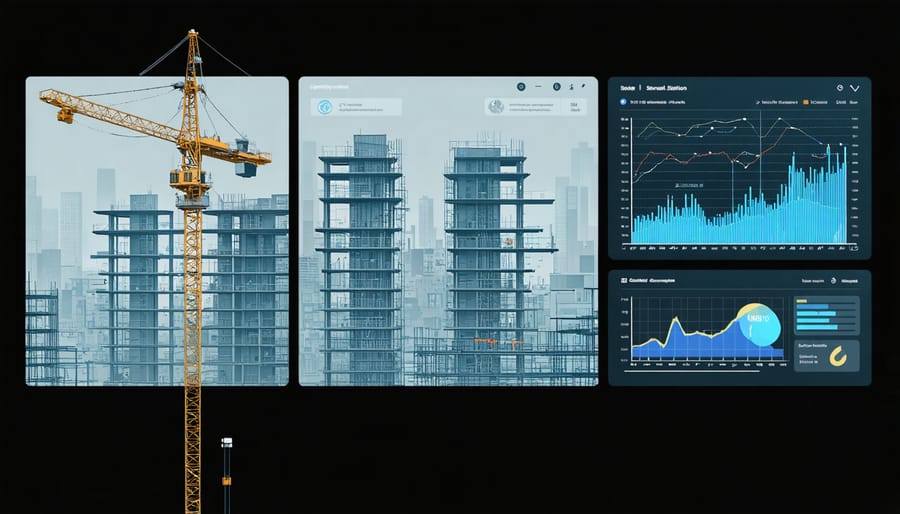Digital transformation in construction demands immediate, robust cybersecurity measures as threat actors increasingly target building information modeling (BIM) systems, project management platforms, and connected jobsite equipment. Recent statistics show that 75% of construction firms experienced cyber incidents during their digitalization journey, with an average cost of $5.2 million per breach. Understanding these cybersecurity risks in construction has become mission-critical for survival in today’s interconnected building environment.
Forward-thinking construction leaders must prioritize three core security pillars while embracing digital innovation: securing cloud-based project data through end-to-end encryption, implementing multi-factor authentication across all digital touchpoints, and establishing real-time monitoring of networked construction equipment. This strategic approach ensures that digital transformation initiatives – from drone surveying to IoT-enabled equipment tracking – enhance rather than compromise operational security.
As construction firms accelerate their technological advancement, cybersecurity can no longer remain an afterthought. It must be woven into the fabric of every digital initiative, from preconstruction planning through project delivery and facility management. This proactive security stance safeguards not just digital assets, but also worker safety, project timelines, and client confidence in an increasingly connected construction landscape.
The Digital Evolution of Construction Sites

Connected Construction Equipment
Connected construction equipment represents a significant advancement in operational efficiency but introduces new cybersecurity challenges. Modern construction sites increasingly rely on IoT-enabled machinery, including excavators, cranes, and earthmoving equipment equipped with sensors and remote monitoring capabilities. These smart machines collect and transmit critical data about performance, maintenance needs, and operational metrics.
However, this connectivity creates potential entry points for cyber threats. Vulnerabilities commonly exist in equipment communication protocols, remote access interfaces, and data transmission systems. Hackers could potentially gain control of machinery, manipulate sensor readings, or steal sensitive project data through these access points.
To protect connected equipment, construction firms must implement robust security measures such as encrypted communications, secure authentication protocols, and regular firmware updates. Regular security assessments of connected machinery, proper network segmentation, and monitoring systems are essential. Equipment operators should receive cybersecurity training to recognize potential threats and follow security protocols.
Organizations should also establish incident response plans specifically for equipment-related cyber incidents, ensuring minimal disruption to construction operations while maintaining site safety and data integrity.
Cloud-Based Project Management
Cloud-based project management tools have become essential for modern construction operations, but they also introduce new security vulnerabilities that require careful attention. When storing sensitive project data, including blueprints, financial information, and client details in the cloud, implementing robust security measures is crucial.
Key security considerations include multi-factor authentication for all team members, role-based access control, and regular security audits of third-party applications. Construction firms should establish clear data classification policies and ensure that project information is encrypted both in transit and at rest.
Industry leaders recommend implementing comprehensive backup solutions and disaster recovery plans for cloud-stored project data. Regular security training for staff members who access these platforms is essential, as human error remains a significant risk factor in data breaches.
When selecting cloud-based project management solutions, organizations should prioritize vendors who comply with industry standards such as ISO 27001 and maintain transparent security protocols. It’s also crucial to establish clear procedures for offboarding departing employees and maintaining an audit trail of all project-related activities.
Best practices include regular security assessments, continuous monitoring of access logs, and maintaining updated incident response plans specific to cloud-based systems.

Critical Security Threats in Construction
BIM Security Vulnerabilities
As construction projects increasingly rely on BIM systems, the security vulnerabilities inherent in these platforms present significant risks to project integrity and organizational safety. The interconnected nature of BIM environments creates multiple entry points for cyber threats, particularly during data exchange between stakeholders and cloud-based collaboration.
Key vulnerabilities include unauthorized access to sensitive design specifications, potential manipulation of structural data, and compromised project coordinates that could affect construction accuracy. Recent industry surveys indicate that 68% of construction firms have experienced at least one BIM-related security incident in the past two years, with data breaches being the most common threat.
The integration of BIM with other digital systems, such as project management software and IoT devices, expands the attack surface considerably. Malicious actors could potentially exploit these connections to gain access to broader construction networks, compromising not only design data but also critical infrastructure controls and security systems.
To mitigate these risks, organizations must implement robust access controls, regular security audits, and encrypted data transmission protocols. Additionally, version control systems should incorporate blockchain technology or similar verification methods to ensure the integrity of BIM data throughout the project lifecycle. Training staff in cybersecurity best practices and establishing clear data handling protocols are essential steps in protecting BIM environments from emerging threats.
Supply Chain Digital Risks
The digitalization of construction supply chains has created new vulnerabilities that require careful attention. As companies integrate digital procurement systems and supplier networks, the potential attack surface for cybercriminals expands significantly. Recent industry studies show that 60% of cyber attacks now come through the supply chain, making it a critical concern for construction firms.
Digital procurement platforms, while efficient, can expose sensitive project data, pricing information, and intellectual property to unauthorized access. When suppliers and subcontractors connect to your systems, each connection represents a potential entry point for malicious actors. This risk is particularly acute in construction, where complex projects often involve dozens of vendors and suppliers accessing shared digital platforms.
To mitigate these risks, construction firms must implement robust vendor risk management programs. This includes conducting thorough cybersecurity assessments of suppliers, establishing clear security requirements in contracts, and maintaining continuous monitoring of third-party access points. Organizations should also enforce strict access controls and implement multi-factor authentication for all supply chain partners.
Building information modeling (BIM) collaboration platforms require special attention, as they often contain valuable project data shared across multiple stakeholders. Encryption of data both in transit and at rest, regular security audits, and clear data handling protocols should be standard practice. Companies should also develop incident response plans that specifically address supply chain breaches, ensuring quick containment and recovery if a supplier’s systems are compromised.
Implementing Robust Digital Security
Access Control Systems
Access control systems form the cornerstone of cybersecurity in digital construction operations, acting as the first line of defense against unauthorized access to sensitive project data and critical systems. Implementation of a robust access control framework requires a multi-layered approach combining identity verification, role-based permissions, and continuous monitoring.
For construction firms, the principle of least privilege (PoLP) should guide access management decisions. This means granting users only the minimum level of access required to perform their specific job functions. Project managers might need full access to project documentation, while subcontractors should only access relevant technical drawings and specifications.
Multi-factor authentication (MFA) has become essential for securing digital assets, particularly when accessing Building Information Modeling (BIM) platforms and project management software. Companies should implement at least two verification methods, such as passwords combined with biometric authentication or security tokens.
Regular access reviews and automated provisioning/de-provisioning processes are crucial, especially given the dynamic nature of construction projects. When team members change roles or leave the project, their access rights must be promptly adjusted or revoked to maintain security integrity.
Emergency access protocols should be established for situations requiring temporary elevation of privileges, ensuring business continuity while maintaining security. These protocols should include detailed documentation requirements and automatic access expiration timeframes.
Identity governance analytics can help track access patterns and identify potential security risks, enabling proactive threat mitigation and compliance with industry regulations.
Data Encryption Protocols
Data encryption serves as a critical defense layer in protecting sensitive construction project information during digital transformation. In the construction industry, where intellectual property, bid information, and client data are increasingly stored digitally, implementing robust encryption protocols is non-negotiable.
Construction firms should prioritize the implementation of AES-256 encryption for data at rest, ensuring that stored project files, specifications, and client information remain secure even if unauthorized access occurs. For data in transit, TLS 1.3 protocols should be utilized to protect information flowing between project management systems, cloud storage, and mobile devices on construction sites.
End-to-end encryption is particularly crucial for protecting sensitive communications between stakeholders, including contract negotiations, change orders, and financial transactions. Construction companies should implement PKI (Public Key Infrastructure) systems to manage digital certificates and encryption keys effectively across multiple project sites and teams.
File-level encryption should be applied to CAD drawings, BIM models, and other proprietary design documents, with access controls integrated into the encryption system. This ensures that only authorized personnel can decrypt and access these critical assets. Additionally, implementing encrypted backup systems helps protect against data loss while maintaining confidentiality.
Regular encryption key rotation and management procedures should be established, with clear protocols for key storage and recovery. This systematic approach to data encryption helps construction firms maintain compliance with data protection regulations while safeguarding their digital assets.
Employee Training Programs
Employee training is the cornerstone of effective cybersecurity in construction’s digital transformation. As construction firms increasingly adopt digital tools and cloud-based solutions, ensuring workforce cybersecurity awareness becomes critical for protecting sensitive project data and maintaining operational continuity.
A comprehensive training program should address three key areas: basic cybersecurity principles, construction-specific digital threats, and incident response protocols. Site supervisors, project managers, and field workers need tailored training that reflects their specific roles and access levels. For instance, workers using mobile devices for daily reporting require different security protocols than project managers handling confidential client data.
Regular training sessions should incorporate real-world scenarios common in construction environments, such as protecting building information modeling (BIM) data, securing remote site communications, and managing access controls for temporary workers and subcontractors. Interactive workshops and simulation exercises have proven particularly effective in reinforcing security practices.
Industry leaders recommend quarterly updates to training materials to address emerging threats and new technologies. Documentation of training completion should be maintained as part of compliance requirements, and periodic assessments help measure program effectiveness.
Construction firms should also implement a buddy system where experienced staff mentor newer employees on security practices, creating a culture of cybersecurity awareness that extends from the office to the job site. This approach has shown significant success in reducing security incidents related to human error.
Future-Proofing Construction Cybersecurity
AI-Powered Security Solutions
Artificial Intelligence is revolutionizing construction cybersecurity through advanced threat detection and automated response mechanisms. Modern AI systems can analyze patterns across construction management platforms, BIM software, and IoT devices to identify potential security breaches before they occur. These solutions are particularly effective in monitoring access controls for sensitive project data and detecting unusual behavior patterns in connected construction equipment.
Machine learning algorithms now enable real-time monitoring of network traffic across construction sites, instantly flagging suspicious activities that could compromise project security. For example, AI-powered systems can detect unauthorized attempts to access critical infrastructure controls or identify potential data exfiltration from project management databases.
Leading construction firms are implementing AI-driven security information and event management (SIEM) systems that provide continuous monitoring of digital assets. These systems can automatically respond to threats by isolating affected systems, revoking compromised credentials, and alerting security teams. The integration of predictive analytics helps identify vulnerable points in the construction technology ecosystem, allowing organizations to strengthen their security measures proactively.
As construction sites become increasingly connected, AI security solutions are proving essential in protecting both digital assets and physical infrastructure from cyber threats.

Blockchain in Construction Security
Blockchain technology in construction is revolutionizing project security through its inherent characteristics of immutability and transparency. Smart contracts automatically execute predefined agreements, ensuring secure and traceable transactions between stakeholders, from material procurement to payment processing.
By implementing blockchain-based project management systems, construction firms can create tamper-proof audit trails for critical documentation, including permits, safety certifications, and design approvals. This significantly reduces the risk of fraud and unauthorized modifications while streamlining compliance verification processes.
Recent implementations have demonstrated blockchain’s effectiveness in securing supply chain management, with real-time tracking of materials and equipment reducing theft and ensuring authenticity of components. The technology also enables secure sharing of sensitive project data among multiple parties while maintaining strict access controls and version histories.
For instance, major construction firms have reported up to 30% reduction in documentation disputes and significant improvements in payment processing security after implementing blockchain-based systems. This technology also facilitates secure integration with IoT devices and sensors, creating a trusted network for monitoring site security and equipment usage.
As the construction industry continues to embrace digital transformation, cybersecurity must remain a cornerstone of this evolution. Construction professionals need to take decisive action to protect their digital assets, project data, and stakeholder information. Begin by conducting a comprehensive security assessment of your current digital infrastructure and identifying potential vulnerabilities in your systems.
Implement a multi-layered security approach that includes robust access controls, regular software updates, and encrypted communication channels. Train your workforce on cybersecurity best practices, ensuring they understand the importance of strong passwords, recognizing phishing attempts, and maintaining data confidentiality. Consider appointing a dedicated cybersecurity team or partner with security experts who understand the unique challenges of the construction sector.
Don’t overlook the importance of regular security audits and penetration testing to identify and address potential weaknesses before they can be exploited. Develop and maintain an incident response plan that outlines clear procedures for addressing security breaches and ensuring business continuity.
Remember that cybersecurity is not a one-time implementation but an ongoing process that requires constant attention and updates. As you continue to adopt new digital tools and technologies, ensure that security considerations are built into every decision and implementation phase. By making cybersecurity a priority in your digital transformation journey, you can confidently embrace technological innovation while protecting your organization’s valuable assets and reputation.

